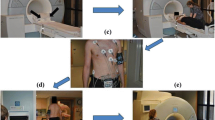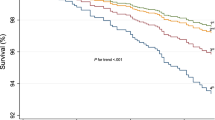Abstract
Background
The benefit of myocardial perfusion imaging (MPI) over exercise ECG stress testing alone is unclear in individuals attaining a workload of ≥10 METS. The purpose of this prospective study is to determine mortality and nonfatal cardiac events in patients at either intermediate pretest risk for CAD or patients with known CAD, achieving ≥10 METS regardless of peak exercise heart rate. The authors previously reported a low prevalence of significant ischemia in this patient cohort.
Methods
Baseline characteristics, ECG stress test findings, and perfusion and function results from quantitative gated 99mTc-SPECT MPI were compared by achievement of a maximum age-predicted heart rate ≥85% in 509 consecutive patients who reached ≥10 METS. Events including all-cause and cardiac mortality, non-fatal myocardial infarction (MI), and late revascularization (>4 weeks after MPI) were prospectively collected.
Results
Of the 509 patients achieving ≥10 METS, follow-up for mortality was obtained in 463 (91%). Those lost to follow-up were older and had higher rates of tobacco use. The prevalences of CAD risk factors, prior known CAD, and MPI abnormalities were higher for the 68 patients failing to reach 85% of their target heart rate. The rate of ≥10% left-ventricular (LV) ischemia by MPI remained very low irrespective of attained heart rate (0.6% (3/463)). Six (1.2%) had an LVEF < 40%. Death occurred in 12 (2.6%) patients, one of which was classified as cardiac (0.1%/year). The other 11 deaths were related to cancer. Additionally, there were three nonfatal MIs (0.7 %) and one late revascularization (0.2%). Only one of these patients had any ischemia on MPI. No cardiac event patient had exercise ST depression or ≥5% LV ischemia.
Conclusions
Thus, patients at intermediate risk for CAD or known CAD achieving ≥10 METS have a very low prevalence of ≥10% LV ischemia and very low rates of cardiac mortality, nonfatal MI, and late revascularization, irrespective of heart rate achieved. Cardiac events did not correlate with abnormalities on the index MPI study. These results suggest that patients who attain ≥10 METS during exercise stress have an excellent prognosis over an intermediate term of follow-up, regardless of peak exercise heart rate achieved. The added value of MPI to standard exercise ECG testing in this population is questionable.


Similar content being viewed by others
References
Gibbons RJ, Balady GJ, Bricker JT, et al. ACC/AHA 2002 guideline update for exercise testing: Summary article. A report of the American College of Cardiology/American Heart Association Task Force on Practice Guidelines (Committee to Update the 1997 Exercise Testing Guidelines). J Am Coll Cardiol 2002;40:1531-40.
Hendel RC, Berman DS, Di Carli MF, et al. ACCF/ASNC/ACR/AHA/ASE/SCCT/SCMR/SNM 2009 Appropriate Use Criteria for Cardiac Radionuclide Imaging: A Report of the American College of Cardiology Foundation Appropriate Use Criteria Task Force, the American Society of Nuclear Cardiology, the American College of Radiology, the American Heart Association, the American Society of Echocardiography, the Society of Cardiovascular Computed Tomography, the Society for Cardiovascular Magnetic Resonance, and the Society of Nuclear Medicine. J Am Coll Cardiol 2009;53:2201-29.
Klocke FJ, Baird MG, Lorell BH, et al. ACC/AHA/ASNC guidelines for the clinical use of cardiac radionuclide imaging—executive summary: A report of the American College of Cardiology/American Heart Association Task Force on Practice Guidelines (ACC/AHA/ASNC Committee to Revise the 1995 Guidelines for the Clinical Use of Cardiac Radionuclide Imaging). J Am Coll Cardiol 2003;42:1318-33.
Balady GJ, Larson MG, Vasan RS, Leip EP, O’Donnell CJ, Levy D. Usefulness of exercise testing in the prediction of coronary disease risk among asymptomatic persons as a function of the Framingham risk score. Circulation 2004;110:1920-5.
Morise AP, Jalisi F. Evaluation of pretest and exercise test scores to assess all-cause mortality in unselected patients presenting for exercise testing with symptoms of suspected coronary artery disease. J Am Coll Cardiol 2003;42:842-50.
Myers J, Prakash M, Froelicher V, Do D, Partington S, Atwood JE. Exercise capacity and mortality among men referred for exercise testing. N Engl J Med 2002;346:793-801.
Goraya TY, Jacobsen SJ, Pellikka PA, et al. Prognostic value of treadmill exercise testing in elderly persons. Ann Intern Med 2000;132:862-70.
Peterson PN, Magid DJ, Ross C, et al. Association of exercise capacity on treadmill with future cardiac events in patients referred for exercise testing. Arch Intern Med 2008;168:174-9.
Mark DB, Shaw L, Harrell FE Jr, et al. Prognostic value of a treadmill exercise score in outpatients with suspected coronary artery disease. N Engl J Med 1991;325:849-53.
Bourque JM, Holland BH, Watson DD, Beller GA. Achieving an exercise workload of > or = 10 metabolic equivalents predicts a very low risk of inducible ischemia: Does myocardial perfusion imaging have a role? J Am Coll Cardiol 2009;54:538-45.
Watson DD, Smith WH II. The role of quantitation in clinical nuclear cardiology: The University of Virginia approach. J Nucl Cardiol 2007;14:466-82.
Hachamovitch R, Hayes SW, Friedman JD, Cohen I, Berman DS. Comparison of the short-term survival benefit associated with revascularization compared with medical therapy in patients with no prior coronary artery disease undergoing stress myocardial perfusion single photon emission computed tomography. Circulation 2003;107:2900-7.
Hachamovitch R, Rozanski A, Hayes SW, et al. Predicting therapeutic benefit from myocardial revascularization procedures: Are measurements of both resting left ventricular ejection fraction and stress-induced myocardial ischemia necessary? J Nucl Cardiol 2006;13:768-78.
Ulm K. A simple method to calculate the confidence interval of a standardized mortality ratio (SMR). Am J Epidemiol 1990;131:373-5.
Lauer MS, Okin PM, Larson MG, Evans JC, Levy D. Impaired heart rate response to graded exercise. Prognostic implications of chronotropic incompetence in the Framingham Heart Study. Circulation 1996;93:1520-6.
Diamond GA, Forrester JS. Analysis of probability as an aid in the clinical diagnosis of coronary-artery disease. N Engl J Med 1979;300:1350-8.
Shaw LJ, Iskandrian AE. Prognostic value of gated myocardial perfusion SPECT. J Nucl Cardiol 2004;11:171-85.
Gasperetti CM, Burwell LR, Beller GA. Prevalence of and variables associated with silent myocardial ischemia on exercise thallium-201 stress testing. J Am Coll Cardiol 1990;16:115-23.
Snader CE, Marwick TH, Pashkow FJ, Harvey SA, Thomas JD, Lauer MS. Importance of estimated functional capacity as a predictor of all-cause mortality among patients referred for exercise thallium single-photon emission computed tomography: Report of 3,400 patients from a single center. J Am Coll Cardiol 1997;30:641-8.
Bhat A, Desai A, Amsterdam EA. Usefulness of high functional capacity in patients with exercise-induced ST-depression to predict a negative result on exercise echocardiography and low prognostic risk. Am J Cardiol 2008;101:1541-3.
Kodama S, Saito K, Tanaka S, et al. Cardiorespiratory fitness as a quantitative predictor of all-cause mortality and cardiovascular events in healthy men and women: A meta-analysis. JAMA 2009;301:2024-35.
Acknowledgment
The authors have indicated that they have no financial conflicts of interest.
Author information
Authors and Affiliations
Corresponding author
Additional information
Dr Bourque is funded by an NIH NRSA Training Grant: T32 EB003841-04.
Rights and permissions
About this article
Cite this article
Bourque, J.M., Charlton, G.T., Holland, B.H. et al. Prognosis in patients achieving ≥10 METS on exercise stress testing: Was SPECT imaging useful?. J. Nucl. Cardiol. 18, 230–237 (2011). https://doi.org/10.1007/s12350-010-9323-2
Received:
Accepted:
Published:
Issue Date:
DOI: https://doi.org/10.1007/s12350-010-9323-2




